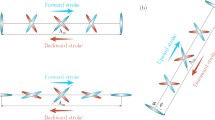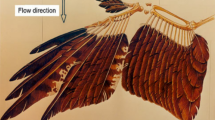Abstract
A new modeling approach is presented for mathematically describing the drag due to wing flapping. It is shown that there is an aerodynamic cost of flapping in terms of an increase in the drag when compared with non-flapping. The drag increase concerns the induced drag which results from lift generation. There are two effects that yield the induced drag increase caused by flapping. The first effect is due to changes in the direction of the lift vectors at the left and right wings during the flapping cycle by tilting them according to the flapping angle of the wings. Because of tilting the lift vectors, more lift has to be generated than is required for the vertical force balance in flapping flight. This lift enlargement causes an increase of the induced drag. The second effect that increases the induced drag is due to changes in the magnitude of the lift vector in the course of the flapping cycle. Changes in the magnitude of the lift vector are necessary for generating thrust which is required for the longitudinal force balance. As a result, both effects of lift vector changes cause a drag increase when compared with non-flapping. Solutions on an analytical basis and as well as results using a computational fluid dynamics method are presented.
Similar content being viewed by others
References
Nguyen Q V, Truong Q T, Park H C, Goo N S, Byun D. Measurement of force produced by an insect-mimicking flapping-wing system. Journal of Bionic Engineering, 2010, 7, S94–S102.
Platzer M F, Jones K D, Young J, Lai J C S. Flapping-wing aerodynamics: Progress and challenges. AIAA Journal, 2008, 46, 2136–2149.
Triantaflyllou M S, Techet A H, Hover F S. Review of experimental work in biomimetic foils. IEEE Journal of Oceanic Engineering, 2004, 29, 585–594.
Shyy W, Berg M, Ljungqvist D. Flapping and flexible wings for biological and micro air vehicles. Progress in Aerospace Sciences, 1999, 35, 455–505.
Tay W B, Bijl H, van Oudheusden, B W. Biplane and tail effects in flapping flight. AIAA Journal 2013, 51, 2133–2146.
Moelyadi M A, Putra H A, Sachs G. Unsteady aerodynamics of flapping wing of a bird. Journal of Engineering and Technological Sciences, 2013, 45, 47–60.
Yoon S, Kang L H, Jo S. Development of air vehicle with active flapping and twisting of wing. Journal of Bionic Engineering, 2011, 8, 1–9.
Nakata T, Liu H, Tanaka Y, Nishihashi N, Wang X, Sato A. Aerodynamics of a bio-inspired flexible flapping-wing micro air vehicle. Bioinspiration & Biomimetics, 6, 1–11.
Tobalske B W. Hovering and intermittent flight in birds. Bioinspiration & Biomimetics, 2010, 5, 1–10.
Hedenström A. Mechanics of bird flight: The power curve of a pigeon by C. J. Pennycuick. The Journal of Experimental Biology, 2009, 212, 1421–1422.
Pennycuick C J. Modelling the Flying Bird, Elsevier LTD, Oxford, UK, 2008.
Tobalske B W. Biomechanics of bird flight. The Journal of Experimental Biology, 2007, 210, 3135–3146.
Askew G N, Ellerby D J. The mechanical power requirements of avian flight. Biology Letters, 2007, 3, 445–448.
Tobalske B W, Hedrick T L, Dial K P, Biewener A A. Comparative power curves in bird flight. Nature, 2003, 421, 363–366.
Rayner J M V, Viscardi P W, Ward S, Speakman J R. Aerodynamics and energetics of intermittent flight in birds. American Zoologist, 2001, 41, 188–204.
Rayner J M V. Estimating power curves of flying vertebrates. The Journal of Experimental Biology, 1999, 202, 3449–3461.
Rayner J M V. Bounding and undulating flight in birds. Journal of Theoretical Biology, 1985, 117, 47–77.
Pennycuick C J. Power requirements for horizontal flight in the pigeon Columba livia. The Journal of Experimental Biology, 1968, 49, 527–555.
Ward-Smith A J. Aerodynamic and energetic considerations relating to undulating and bounding flight in birds. Journal of Theoretical Biology, 1984, 111, 407–417.
Norberg U M. Vertebrate Flight, Springer, Berlin, Germany, 1990.
Roskam J, Lan C-T E. Airplane Aerodynamics and Performance, DAR corporation, Lawrence, Kansa, USA, 1997.
Heuser H. Lehrbuch der Analysis, Teil: 1. Teubner, Stuttgart, Germany, 1990.
Muijres F T, Spedding G R, Winter Y, Hedenström A. Actuator disk model and span efficiency of flapping flight in bats based on time-resolved PIV measurements. Experiments in Fluids, 2011, 51, 511–525.
Cvrlje T, Breitsamter C, Weishäupl C, Laschka B. Euler and navier-stokes simulations of two-stage hypersonic vehicle longitudinal motions. Journal of Spacecraft and Rockets, 2002, 37, 242–251.
Jiang L, Moelyadi M A, Breitsamter C. Aerodynamic investigations on the unsteady stage separation of a TSTO space transport system. Forschungsbericht FLM-2003/34, Lehrstuhl für Fluidmechanik, Abteilung Aerodynamik, Technische Universität München, 2003.
Cvrlje T. Instationäre Aerodynamik des Separationsvorgangs Zwischen Träger und Orbiter. Dissertation, Technische Universität München, Germany, 2001.
Liou M S, Steffen C J. A new flux splitting scheme. Journal of Computational Physics, 1993, 107, 23–39.
Herzog K. Anatomie und Flugbiologie der Vögel. Gustav Fischer Verlag, Stuttgart, Germany, 1968.
Author information
Authors and Affiliations
Corresponding author
Rights and permissions
About this article
Cite this article
Sachs, G. Aerodynamic Cost of Flapping. J Bionic Eng 12, 61–69 (2015). https://doi.org/10.1016/S1672-6529(14)60100-1
Published:
Issue Date:
DOI: https://doi.org/10.1016/S1672-6529(14)60100-1




